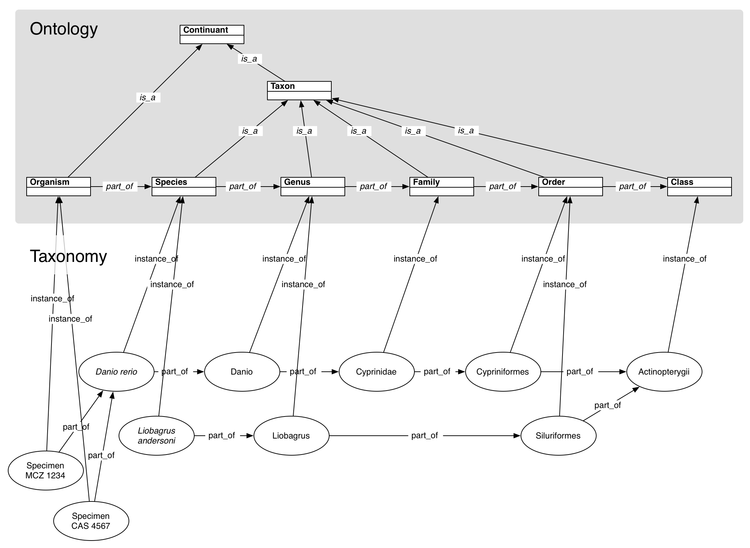Taxonomic Rank Ontology
A taxonomic rank ontology allows particular taxa to be treated as historical individuals instead of as universal types.

Previous attempts to represent taxonomy using ontology usually include taxonomic groups as classes in the ontology. Individual organisms are seen as instances of those universal types. There could be an ontology term Mammal, such that Primates and Rodents are more particular types of Mammals (is_a descendants). Taxonomies are even often used as examples to help explain ontology inheritance to new users. This scheme fails to represent reality in several ways and, as this page will demonstrate, is even misleading.
Contents
Inference with traditional taxonomy
One of the attractions of a traditional taxonomy for ontology builders that it can support the most common sort of reasoning for Description Logic ontologies. Although neither the TTO nor the NCBI taxonomy ontology attach character values to their classes, in principle such characters could be extracted from keys or from the taxonomic literature. With the addition of such properties, individuals can be classified by starting at the root of the taxonomy and traversing down the tree until either a terminal taxon (species) is reached or a node is reached where no descendant has the combination of characters displayed by the individual. For biologists, this operation is identical to use of an identification key. Such an operation is generally only defined for is_a links.
Although a class hierarchy supports inference by classification, it does not support other sorts of inference, particular those that flow bottom up from instances to classes.
Problems with the "traditional" view
- The only criterion for inclusion within a taxonomic group is physical descent from a member of that group (we are assuming a taxonomy consistent with phylogeny). There are no universal properties one could ascribe to members of "Mammalia", besides things the members happen to share at this moment. "Hair" is often used an example of a Mammalian property; but of course its commonality is the result of its presence in the common ancestor of all mammals, and many mammals lack hair almost entirely. A mammal species that had no hair at all would nevertheless still be a mammal. Such reversals are common in phylogenies and can occur for both morphological properties (e.g., loss of legs in snakes) and molecular characters (e.g., inferred origin of pseudogenes).
- Properties of a taxonomic group change through time: its geographic range, genetic and morphological diversity, etc. It can go extinct.
- Treating taxonomic groups as "classes" or "types" reinforces essentialist ideas of life forms, which evolutionary biology has completely overturned. Essentialist thought is a hindrance to understanding of the evolutionary process.
Instead treating taxa as types in an ontology, we can treat individual taxa as instances of the type Taxon, or more specifically as instances of some taxonomic rank (see figure above).
Taxonomic Rank Ontology + Instance Graph of Taxonomy
Advantages
- Taxa are modeled as individuals.
- Taxonomic rank terms are ordered through their part_of relationships.
- Multiple part_of parents introduce fewer problems in inference than multiple is_a parents. This is important as more cases of reticulate phylogeny, caused by, for example, cross species hybridization or horizontal gene transfer, are discovered.